六、自定义映射resultMap
解决字段名和属性名不一致的情况
方式一
给属性起别名在sql语句中
数据库中的名字

实体类中的名字
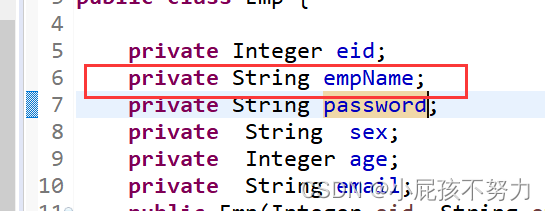
起别名

方式二
在config.xml中使用< settings>< /settings> 设置MyBatis的全局配置 ! 注意标签的放的位置
将下划线_自动映射为驼峰命名 emp_name : empName
<settings>
<setting name="mapUnderscoreToCamelCase" value="true"/>
</settings>
方式三
resultMap:设置自定义映射
属性:
id:表示自定义映射的唯一标识
type:查询的数据要映射的实体类的类型
子标签:
id:设置主键的映射关系
result:设置普通字段的映射关系
association:设置多对一的映射关系
collection:设置一对多的映射关系
属性:
property:设置映射关系中实体类中的属性名
column:设置映射关系中表中的字段名
<resultMap id="userMap" type="User">
<id property="id" column="id"></id>
<result property="userName" column="user_name"></result>
<result property="password" column="password"></result>
<result property="age" column="age"></result>
<result property="sex" column="sex"></result>
</resultMap>
<select id="getAllEmp" resultMap="empResultMap">
select eid,emp_name empName,password,age,sex,email from t_emp
</select>
七、多对一与一对多映射处理
查询员工信息以及员工所对应的部门信息
方法一:级联属性赋值
column是数据库中字段的名字
property 是实体类中的属性
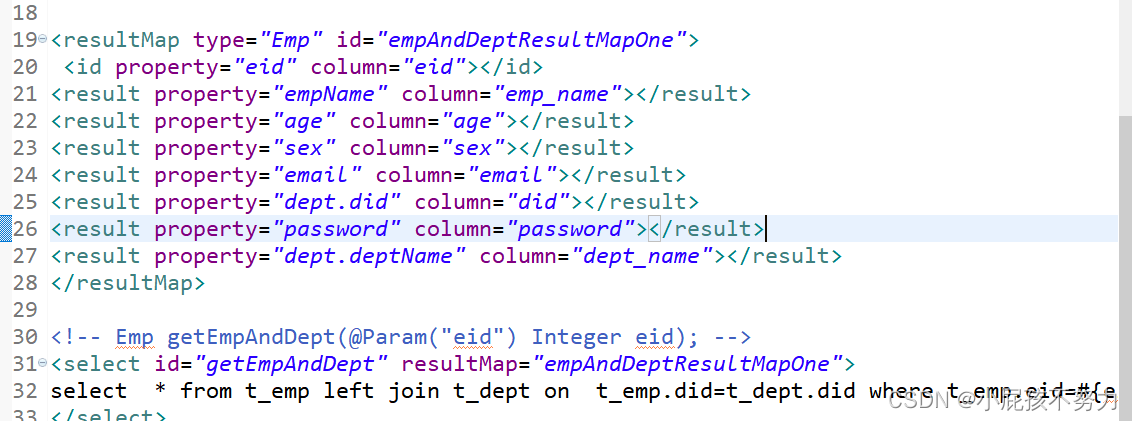
2.使用association处理多对一映射关系
property :需要处理多对一映射关系的属性名
javaType:该属性对应的那个实体类
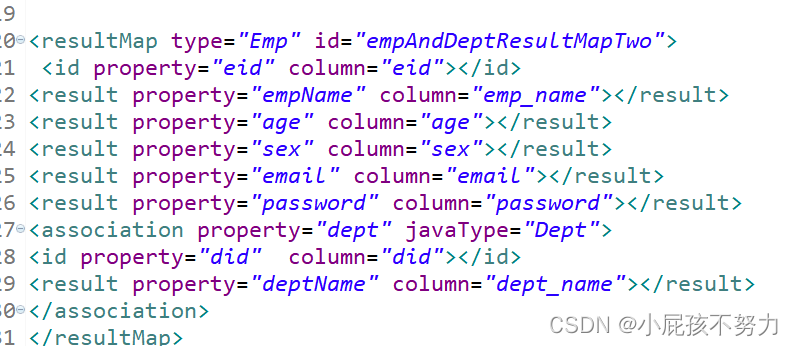
3.分步查询
**1)**查询员工信息
/**
* 通过分步查询查询员工信息
* @param eid
* @return
*/
Emp getEmpByStep(@Param("eid") int eid);
/**
- 通过分步查询查询员工信息
- @param eid
- @return
*/
Emp getEmpByStep(@Param(“eid”) int eid);
<resultMap id="empDeptStepMap" type="Emp">
<id column="eid" property="eid"></id>
<result column="ename" property="ename"></result>
<result column="age" property="age"></result>
<result column="sex" property="sex"></result>
<!--
select:设置分步查询,查询某个属性的值的sql的标识(namespace.sqlId)
column:将sql以及查询结果中的某个字段设置为分步查询的条件
-->
<association property="dept"
select="com.atguigu.MyBatis.mapper.DeptMapper.getEmpDeptByStep" column="did">
</association>
</resultMap>
<!--Emp getEmpByStep(@Param("eid") int eid);-->
<select id="getEmpByStep" resultMap="empDeptStepMap">
select * from t_emp where eid = #{eid}
</select>
**2)**根据员工所对应的部门id查询部门信息
/**
* 分步查询的第二步:根据员工所对应的did查询部门信息
* @param did
* @return
*/
Dept getEmpDeptByStep(@Param("did") int did);
<!--Dept getEmpDeptByStep(@Param("did") int did);-->
<select id="getEmpDeptByStep" resultType="Dept">
select * from t_dept where did = #{did}
</select>
分步查询的优点:可以实现延迟加载,但是必须在核心配置文件中设置全局配置信息:
lazyLoadingEnabled:延迟加载的全局开关。当开启时,所有关联对象都会延迟加载
aggressiveLazyLoading:当开启时,任何方法的调用都会加载该对象的所有属性。 否则,每个
属性会按需加载
此时就可以实现按需加载,获取的数据是什么,就只会执行相应的sql。此时可通过association和
collection中的fetchType属性设置当前的分步查询是否使用延迟加载,fetchType=“lazy(延迟加
载)|eager(立即加载)”
一对多查询
根据部门id查新部门以及部门中的员工信息、一个部门有多个员工
使用collection标签
1.目的:设置字段和属性的映射关系
2.通过ofType获取集合里存储的数据类型
3.然后根据这个类型获取相应的属性
4.映射关系建立后,创建该类型的对象(此处是emp)
5.最后把每一个对象放在集合 emps中
/**
* 根据部门id查新部门以及部门中的员工信息
* @param did
* @return
*/
Dept getDeptEmpByDid(@Param("did") int did);
<resultMap id="deptEmpMap" type="Dept">
<id property="did" column="did"></id>s
<result property="dname" column="dname"></result>
<!--
ofType:设置collection标签所处理的集合属性中存储数据的类型
-->
<collection property="emps" ofType="Emp">
<id property="eid" column="eid"></id>
<result property="ename" column="ename"></result>
<result property="age" column="age"></result>
<result property="sex" column="sex"></result>
</collection>
</resultMap>
<!--Dept getDeptEmpByDid(@Param("did") int did);-->
<select id="getDeptEmpByDid" resultMap="deptEmpMap">
select dept.*,emp.* from t_dept dept left join t_emp emp on dept.did =
emp.did where dept.did = #{did}
</select>
collection:处理一对多的映射关系
ofType 表示该属性所对应的集合中存储数据的类型
分布查询
分布查询第一步: 查询部门信息
/**
* 分步查询部门和部门中的员工
* @param did
* @return
*/
Dept getDeptByStep(@Param("did") int did);
<resultMap id="deptEmpStep" type="Dept">
<id property="did" column="did"></id>
<result property="dname" column="dname"></result>
<collection property="emps" fetchType="eager"
select="com.atguigu.MyBatis.mapper.EmpMapper.getEmpListByDid" column="did">
</collection>
</resultMap>
<!--Dept getDeptByStep(@Param("did") int did);-->
<select id="getDeptByStep" resultMap="deptEmpStep">
select * from t_dept where did = #{did}
</select>
-->
2)根据部门id查询部门中的所有员工
/**
* 根据部门id查询员工信息
* @param did
* @return
*/
List<Emp> getEmpListByDid(@Param("did") int did);
<!--List<Emp> getEmpListByDid(@Param("did") int did);-->
<select id="getEmpListByDid" resultType="Emp">
select * from t_emp where did = #{did}
</select>
八、动态SQL
1.if :根据标签中的test属性所对应的表达式决定标签中的内容是否需要拼接到sql中
<select id="getEmpByCondition" resultType="Emp">
select * from t_emp where 1=1
<if test="empName !=null and empName!='' ">
and emp_name=#{empName}
</if>
<if test="age !=null and age!=''">
and age=#{age}
</if>
<if test="sex !=null and sex!=''">
and sex=#{sex}
</if>
<if test="email !=null and email!=''">
and email=#{email}
</if>
</select>
where 当where 有内容时会自动生成where关键字,并且将内容前多余的and 或or 去掉
当where标签中没有内容时,此时where 标签没有任何效果
where 标签不能将其中内容后面多余的and 或or 去掉
<select id="getEmpByCondition" resultType="Emp">
select * from t_emp
<where>
<if test="empName !=null and empName!='' ">
and emp_name = #{empName}
</if>
<if test="age !=null and age!=''">
and age=#{age}
</if>
<if test="sex !=null and sex!=''">
and sex=#{sex}
</if>
<if test="email !=null and email!=''">
and email=#{email}
</if>
</where>
</select>
3.trim
prefix: 将trim 标签中内容前面添加指定内容
suffix:将trim 标签中内容后面添加指定内容
suffixOverrides : 将trim标签后面指定内容去掉
prefixOverrides:将trim标签前面指定内容去掉
若 trim 标签中没有内容时,trim标签也没有任何效果
<select id="getEmpByCondition" resultType="Emp">
select * from t_emp
<trim prefix="where" suffixOverrides="and|or">
<if test="empName !=null and empName!='' ">
emp_name = #{empName} and
</if>
<if test="age !=null and age!=''">
age=#{age} and
</if>
<if test="sex !=null and sex!=''">
sex=#{sex} and
</if>
<if test="email !=null and email!=''">
email=#{email}
</if>
</trim>
4.choose when otherwise 相当于 if …else if…else
when 标签中有一个成立则其他when标签里的内容不会继续拼接
若都不成立 可以执行 otherwise 标签内的内容
when 标签至少有一个 otherwise至多有一个
<select id="getEmpByChoose" resultType="Emp">
select * from t_emp
<where>
<choose>
<when test="empName !=null and empName!='' ">
emp_name = #{empName}
</when>
<when test="empName !=null and empName!='' ">
age = #{age}
</when>
<when test="empName !=null and empName!='' ">
sex = #{sex}
</when>
<when test="empName !=null and empName!='' ">
email = #{email}
</when>
<otherwise>
did =1
</otherwise>
</choose>
<!--实现动态修改-->
<update id="updateUser">
update user
<set>
<if test="username!=null and username!=''">
username=#{username},
</if>
<if test="sex!=null and sex!=''">
sex=#{sex},
</if>
<if test="phone!=null and phone!=''">
phone=#{phone},
</if>
</set>
where id=#{id}
</update>
5.foreach标签
属性:
collection:设置要循环的数组或集合
item:表示集合或数组中的每一个数据
separator:设置循环体之间的分隔符
open:设置foreach标签中的内容的开始符
close:设置foreach标签中的内容的结束符
用foreach实现批量删除
int deleteMoreByArray(@Param("eids")Integer [] eids);
<delete id="deleteMoreByArray">
delete from t_emp where eid in
<foreach collection="eids" item="eid"
separator="," open="(" close=")">
${eid}
</foreach>
</delete>
<delete id="deleteMoreByArray">
delete from t_emp where
<foreach collection="eids" item="eid" separator="or">
eid=${eid}
</foreach>
</delete>
批量添加
<insert id="insertMoreEmp">
insert into t_emp values
<foreach collection="emps" item="emp" separator=",">
(null,#{emp.ename},#{emp.age},#{emp.sex},#{emp.email},null)
</foreach>
</insert>
6、SQL片段
sql片段,可以记录一段公共sql片段,在使用的地方通过include标签进行引入
<sql id="empColumns">
eid,ename,age,sex,did
</sql>
select <include refid="empColumns"></include> from t_emp
九、MyBatis的缓存
1、MyBatis的一级缓存
一级缓存是SqlSession级别的,通过同一个SqlSession查询的数据会被缓存,下次查询相同的数据,就
会从缓存中直接获取,不会从数据库重新访问
使一级缓存失效的四种
使一级缓存失效的四种情况:
- 不同的SqlSession对应不同的一级缓存
- 同一个SqlSession但是查询条件不同
- 同一个SqlSession两次查询期间执行了任何一次增删改操作
- 同一个SqlSession两次查询期间手动清空了缓存情况:
2、MyBatis的二级缓存
二级缓存是SqlSessionFactory级别,通过同一个SqlSessionFactory创建的SqlSession查询的结果会被
缓存;此后若再次执行相同的查询语句,结果就会从缓存中获取
二级缓存开启的条件:
a>在核心配置文件中,设置全局配置属性cacheEnabled=“true”,默认为true,不需要设置
b>在映射文件中设置标签< cache />
c>二级缓存必须在SqlSession关闭或提交之后有效
d>查询的数据所转换的实体类类型必须实现序列化的接口
使二级缓存失效的情况:
两次查询之间执行了任意的增删改,会使一级和二级缓存同时失效
3、二级缓存的相关配置
在mapper配置文件中添加的cache标签可以设置一些属性:
eviction属性:缓存回收策略
LRU(Least Recently Used) – 最近最少使用的:移除最长时间不被使用的对象。
FIFO(First in First out) – 先进先出:按对象进入缓存的顺序来移除它们。
SOFT – 软引用:移除基于垃圾回收器状态和软引用规则的对象。
WEAK – 弱引用:更积极地移除基于垃圾收集器状态和弱引用规则的对象。
默认的是 LRU。
flushInterval属性:刷新间隔,单位毫秒
默认情况是不设置,也就是没有刷新间隔,缓存仅仅调用语句时刷新
size属性:引用数目,正整数
代表缓存最多可以存储多少个对象,太大容易导致内存溢出
readOnly属性:只读,true/false
true:只读缓存;会给所有调用者返回缓存对象的相同实例。因此这些对象不能被修改。这提供了
很重要的性能优势。
false:读写缓存;会返回缓存对象的拷贝(通过序列化)。这会慢一些,但是安全,因此默认是
false。
4、MyBatis缓存查询的顺序
先查询二级缓存,因为二级缓存中可能会有其他程序已经查出来的数据,可以拿来直接使用。
如果二级缓存没有命中,再查询一级缓存
如果一级缓存也没有命中,则查询数据库
SqlSession关闭之后,一级缓存中的数据会写入二级缓存
5、整合第三方缓存EHCache
添加依赖
<!-- Mybatis EHCache整合包 -->
<dependency>
<groupId>org.mybatis.caches</groupId>
<artifactId>mybatis-ehcache</artifactId>
<version>1.2.1</version>
</dependency>
<!-- slf4j日志门面的一个具体实现 -->
<dependency>
<groupId>ch.qos.logback</groupId>
<artifactId>logback-classic</artifactId>
<version>1.2.3</version>
</dependency>
c>创建EHCache的配置文件ehcache.xml
<?xml version="1.0" encoding="utf-8" ?>
<ehcache xmlns:xsi="http://www.w3.org/2001/XMLSchema-instance"
xsi:noNamespaceSchemaLocation="../config/ehcache.xsd">
<!-- 磁盘保存路径 -->
<diskStore path="D:\atguigu\ehcache" />
<defaultCache maxElementsInMemory="1000"
maxElementsOnDisk="10000000" eternal="false" overflowToDisk="true"
timeToIdleSeconds="120" timeToLiveSeconds="120"
diskExpiryThreadIntervalSeconds="120" memoryStoreEvictionPolicy="LRU">
</defaultCache>
</ehcache>
设置二级缓存的类型
在要开启的mapper.xml中设置
<cache type="org.mybatis.caches.ehcache.EhcacheCache"/>
加入logback日志
存在SLF4J时,作为简易日志的log4j将失效,此时我们需要借助SLF4J的具体实现logback来打印日志。
创建logback的配置文件logback.xml
<?xml version="1.0" encoding="UTF-8"?>
<configuration debug="true">
<!-- 指定日志输出的位置 -->
<appender name="STDOUT" class="ch.qos.logback.core.ConsoleAppender">
<encoder>
<pattern>[%d{HH:mm:ss.SSS}] [%-5level] [%thread] [%logger]
[%msg]%n</pattern>
</encoder>
</appender>
<root level="DEBUG">
<appender-ref ref="STDOUT" />
</root>
<!-- 根据特殊需求指定局部日志级别 -->
<logger name="com.atguigu.crowd.mapper" level="DEBUG" />
</configuration>
十、MyBatis的逆向工程
正向工程:先创建Java实体类,由框架负责根据实体类生成数据库表。Hibernate是支持正向工程
的。
逆向工程:先创建数据库表,由框架负责根据数据库表,反向生成如下资源:
Java实体类
Mapper接口
Mapper映射文件
1、创建逆向工程的步骤
a>添加依赖和插件
<properties>
<project.build.sourceEncoding>UTF-8</project.build.sourceEncoding>
</properties>
<dependencies>
<dependency>
<groupId>org.mybatis</groupId>
<artifactId>mybatis</artifactId>
<version>3.5.7</version>
</dependency>
<dependency>
<groupId>log4j</groupId>
<artifactId>log4j</artifactId>
<version>1.2.17</version>
</dependency>
<dependency>
<groupId>junit</groupId>
<artifactId>junit</artifactId>
<version>4.12</version>
<scope>test</scope>
</dependency>
<!-- MySQL驱动 -->
<dependency>
<groupId>mysql</groupId>
<artifactId>mysql-connector-java</artifactId>
<version>8.0.11</version>
</dependency>
</dependencies>
<!-- 控制Maven在构建过程中相关配置 -->
<build>
<!-- 构建过程中用到的插件 -->
<plugins>
<!-- 具体插件,逆向工程的操作是以构建过程中插件形式出现的 -->
<plugin>
<groupId>org.mybatis.generator</groupId>
<artifactId>mybatis-generator-maven-plugin</artifactId>
<version>1.3.0</version>
<!-- 插件的依赖 -->
<dependencies>
<!-- 逆向工程的核心依赖 -->
<dependency>
<groupId>org.mybatis.generator</groupId>
<artifactId>mybatis-generator-core</artifactId>
<version>1.3.2</version>
</dependency>
<!-- 数据库连接池 -->
<dependency>
<groupId>com.mchange</groupId>
<artifactId>c3p0</artifactId>
<version>0.9.2</version>
</dependency>
<!-- MySQL驱动 -->
<dependency>
<groupId>mysql</groupId>
<artifactId>mysql-connector-java</artifactId>
<version>8.0.11</version>
</dependency>
</dependencies>
</plugin>
</plugins>
</build>
b>创建MyBatis的核心配置文件
c>创建逆向工程的配置文件
注意!
文件名必须是:generatorConfig.xml
<?xml version="1.0" encoding="UTF-8"?>
<!DOCTYPE generatorConfiguration
PUBLIC "-//mybatis.org//DTD MyBatis Generator Configuration 1.0//EN"
"http://mybatis.org/dtd/mybatis-generator-config_1_0.dtd">
<generatorConfiguration>
<!-- targetRuntime: 执行生成的逆向工程的版本 MyBatis3Simple: 生成基本的CRUD(清新简洁版) MyBatis3:
生成带条件的CRUD(奢华尊享版) -->
<context id="DB2Tables" targetRuntime="MyBatis3Simple">
<!-- 数据库的连接信息 -->
<jdbcConnection driverClass="com.mysql.cj.jdbc.Driver"
connectionURL="jdbc:mysql://localhost:3306/mybatis?&useSSL=false&serverTimezone=UTC&characterEncoding=utf-8"
userId="root"
password="root">
</jdbcConnection>
<!-- javaBean的生成策略 -->
<javaModelGenerator targetPackage="com.ycx.pojo"
targetProject=".\src\main\java">
<property name="enableSubPackages" value="true" />
<property name="trimStrings" value="true" />
</javaModelGenerator>
<!-- SQL映射文件的生成策略 -->
<sqlMapGenerator targetPackage="com.ycx.mapper"
targetProject=".\src\main\resources">
<property name="enableSubPackages" value="true" />
</sqlMapGenerator>
<!-- Mapper接口的生成策略 -->
<javaClientGenerator type="XMLMAPPER"
targetPackage="com.ycx.mapper" targetProject=".\src\main\java">
<property name="enableSubPackages" value="true" />
</javaClientGenerator>
<!-- 逆向分析的表 -->
<!-- tableName设置为*号,可以对应所有表,此时不写domainObjectName -->
<!-- domainObjectName属性指定生成出来的实体类的类名 -->
<table tableName="t_emp" domainObjectName="Emp" />
<table tableName="t_dept" domainObjectName="Dept" />
</context>
</generatorConfiguration>
执行

没有的话在
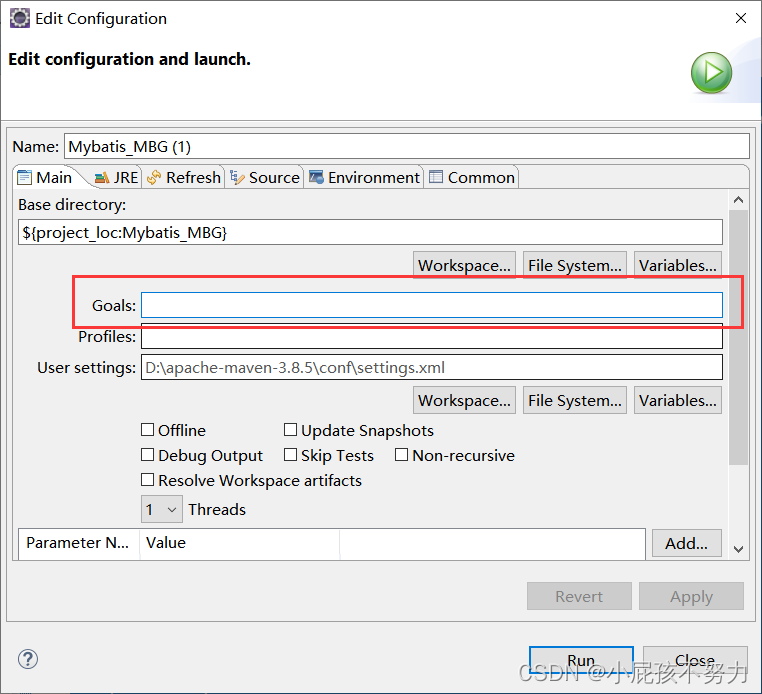
填入

QBC查询
@Test
public void testMBG() throws IOException {
InputStream is = Resources.getResourceAsStream("mybatis-config.xml");
SqlSession sqlSession = new
SqlSessionFactoryBuilder().build(is).openSession(true);
EmpMapper mapper = sqlSession.getMapper(EmpMapper.class);
EmpExample empExample = new EmpExample();
//创建条件对象,通过andXXX方法为SQL添加查询添加,每个条件之间是and关系
empExample.createCriteria().andEnameLike("a").andAgeGreaterThan(20).andDidIsNot
Null();
//将之前添加的条件通过or拼接其他条件
empExample.or().andSexEqualTo("男");
List<Emp> list = mapper.selectByExample(empExample);
for (Emp emp : list) {
System.out.println(emp);
}
}
十一 、分页插件
1.添加依赖
<!-- https://mvnrepository.com/artifact/com.github.pagehelper/pagehelper -->
<dependency>
<groupId>com.github.pagehelper</groupId>
<artifactId>pagehelper</artifactId>
<version>5.2.0</version>
</dependency>
配置分页插件
在MyBatis的核心配置文件中配置插件(标签有顺序)
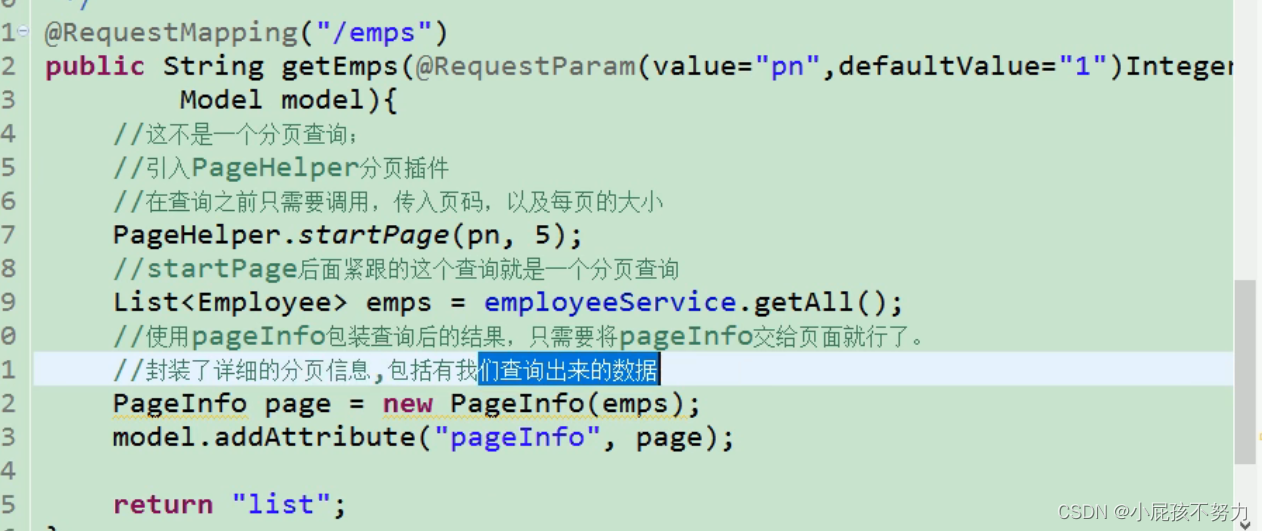
<plugins>
<!--设置分页插件-->
<plugin interceptor="com.github.pagehelper.PageInterceptor"></plugin>
</plugins>
使用Mybatis的分页插件实现分页功能
1.需要在查询功能之前开启分页
PageHelper.startPage(int pageNum,int pageSize);
常用数据:
pageNum:当前页的页码
pageSize:每页显示的条数
size:当前页显示的真实条数
total:总记录数
pages:总页数
prePage:上一页的页码
nextPage:下一页的页码
常用数据:
pageNum:当前页的页码
pageSize:每页显示的条数
size:当前页显示的真实条数
total:总记录数
pages:总页数
prePage:上一页的页码
nextPage:下一页的页码

若还有没有的数据则使用

其中的 第一个参数是 查询出来的表的集合(分页数据) 第二个参数是 你想展示的导航页码 建议奇数




















 4828
4828











 被折叠的 条评论
为什么被折叠?
被折叠的 条评论
为什么被折叠?








